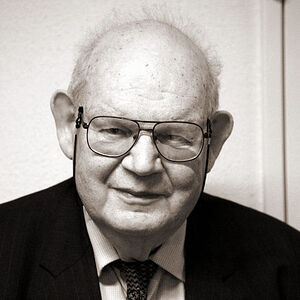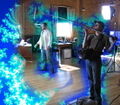Benoit Mandelbrot (nonfiction): Difference between revisions
No edit summary |
|||
| (5 intermediate revisions by the same user not shown) | |||
| Line 1: | Line 1: | ||
[[File:Benoit_Mandelbrot.jpg|thumb|Benoit Mandelbrot.]]'''Benoit B. Mandelbrot''' (20 November 1924 – 14 October 2010) was a Polish-born, French and American [[Mathematician (nonfiction)|mathematician]] with broad interests in practical sciences, especially regarding what he labeled as "the art of roughness" of physical phenomena and "the uncontrolled element in life." | [[File:Benoit_Mandelbrot.jpg|thumb|Benoit Mandelbrot.]]'''Benoit B. Mandelbrot''' (20 November 1924 – 14 October 2010) was a Polish-born, French and American [[Mathematician (nonfiction)|mathematician]] and polymath with broad interests in the practical sciences, especially regarding what he labeled as "the art of roughness" of physical phenomena and "the uncontrolled element in life". He referred to himself as a "fractalist" and is recognized for his contribution to the field of fractal geometry, which included coining the word "fractal", as well as developing a theory of "roughness and self-similarity" in nature. | ||
He | In 1936, while he was a child, Mandelbrot's family emigrated to France from Warsaw, Poland. After World War II ended, Mandelbrot studied mathematics, graduating from universities in Paris and the United States and receiving a master's degree in aeronautics from the California Institute of Technology. He spent most of his career in both the United States and France, having dual French and American citizenship. In 1958, he began a 35-year career at IBM, where he became an IBM Fellow, and periodically took leaves of absence to teach at Harvard University. At Harvard, following the publication of his study of U.S. commodity markets in relation to cotton futures, he taught economics and applied sciences. | ||
Because of his access to IBM's computers, Mandelbrot was one of the first to use computer graphics to create and display fractal geometric images, leading to his discovery of the Mandelbrot set in 1980. He showed how visual complexity can be created from simple rules. He said that things typically considered to be "rough", a "mess" or "chaotic", like clouds or shorelines, actually had a "degree of order". His math and geometry-centered research career included contributions to such fields as statistical physics, meteorology, hydrology, geomorphology, anatomy, taxonomy, neurology, linguistics, information technology, computer graphics, economics, geology, medicine, physical cosmology, engineering, chaos theory, econophysics, metallurgy and the social sciences. | |||
Toward the end of his career, he was Sterling Professor of Mathematical Sciences at Yale University, where he was the oldest professor in Yale's history to receive tenure. Mandelbrot also held positions at the Pacific Northwest National Laboratory, Université Lille Nord de France, Institute for Advanced Study and Centre National de la Recherche Scientifique. During his career, he received over 15 honorary doctorates and served on many science journals, along with winning numerous awards. His autobiography, ''The Fractalist: Memoir of a Scientific Maverick'', was published posthumously in 2012. | |||
== In the News == | == In the News == | ||
<gallery | <gallery> | ||
File:Mandelbrot set command line depiction.png|link=Mandelbrot set (nonfiction)|ASCII-art [[Mandelbrot set (nonfiction)|Mandelbrot set]] yearns for color, launches Kickstarter campaign to fund ugrade. | File:Mandelbrot set command line depiction.png|link=Mandelbrot set (nonfiction)|ASCII-art [[Mandelbrot set (nonfiction)|Mandelbrot set]] yearns for color, launches Kickstarter campaign to fund ugrade. | ||
File:Edward Lorenz.jpg|link=Edward Lorenz (nonfiction)|[[Edward Lorenz (nonfiction)|Edward Lorenz]]. | File:Edward Lorenz.jpg|link=Edward Lorenz (nonfiction)|[[Edward Lorenz (nonfiction)|Edward Lorenz]] pleased with recent spell of fine weather. | ||
File:Mandelbrot-AI-interview.jpg|link=Benoit Mandelbrot|Artist-Engineers prepare an interface to the famed artificial intelligence [[Benoit Mandelbrot]]. | File:Mandelbrot-AI-interview.jpg|link=Benoit Mandelbrot|Artist-Engineers prepare an interface to the famed artificial intelligence [[Benoit Mandelbrot]]. | ||
</gallery> | </gallery> | ||
== Fiction cross-reference == | |||
* [[Gnomon algorithm]] | |||
* [[Gnomon Chronicles]] | |||
* [[Benoit Mandelbrot]] | |||
== Nonfiction cross-reference == | == Nonfiction cross-reference == | ||
* [[Gaston Julia (nonfiction)]] | |||
* [[Lorenz system (nonfiction)]] | * [[Lorenz system (nonfiction)]] | ||
* [[Mandelbrot set (nonfiction)]] | * [[Mandelbrot set (nonfiction)]] | ||
External links: | |||
* [https://en.wikipedia.org/wiki/Benoit_Mandelbrot Benoit Mandelbrot] @ Wikipedia | * [https://en.wikipedia.org/wiki/Benoit_Mandelbrot Benoit Mandelbrot] @ Wikipedia | ||
Latest revision as of 19:44, 20 November 2019
Benoit B. Mandelbrot (20 November 1924 – 14 October 2010) was a Polish-born, French and American mathematician and polymath with broad interests in the practical sciences, especially regarding what he labeled as "the art of roughness" of physical phenomena and "the uncontrolled element in life". He referred to himself as a "fractalist" and is recognized for his contribution to the field of fractal geometry, which included coining the word "fractal", as well as developing a theory of "roughness and self-similarity" in nature.
In 1936, while he was a child, Mandelbrot's family emigrated to France from Warsaw, Poland. After World War II ended, Mandelbrot studied mathematics, graduating from universities in Paris and the United States and receiving a master's degree in aeronautics from the California Institute of Technology. He spent most of his career in both the United States and France, having dual French and American citizenship. In 1958, he began a 35-year career at IBM, where he became an IBM Fellow, and periodically took leaves of absence to teach at Harvard University. At Harvard, following the publication of his study of U.S. commodity markets in relation to cotton futures, he taught economics and applied sciences.
Because of his access to IBM's computers, Mandelbrot was one of the first to use computer graphics to create and display fractal geometric images, leading to his discovery of the Mandelbrot set in 1980. He showed how visual complexity can be created from simple rules. He said that things typically considered to be "rough", a "mess" or "chaotic", like clouds or shorelines, actually had a "degree of order". His math and geometry-centered research career included contributions to such fields as statistical physics, meteorology, hydrology, geomorphology, anatomy, taxonomy, neurology, linguistics, information technology, computer graphics, economics, geology, medicine, physical cosmology, engineering, chaos theory, econophysics, metallurgy and the social sciences.
Toward the end of his career, he was Sterling Professor of Mathematical Sciences at Yale University, where he was the oldest professor in Yale's history to receive tenure. Mandelbrot also held positions at the Pacific Northwest National Laboratory, Université Lille Nord de France, Institute for Advanced Study and Centre National de la Recherche Scientifique. During his career, he received over 15 honorary doctorates and served on many science journals, along with winning numerous awards. His autobiography, The Fractalist: Memoir of a Scientific Maverick, was published posthumously in 2012.
In the News
ASCII-art Mandelbrot set yearns for color, launches Kickstarter campaign to fund ugrade.
Edward Lorenz pleased with recent spell of fine weather.
Artist-Engineers prepare an interface to the famed artificial intelligence Benoit Mandelbrot.
Fiction cross-reference
Nonfiction cross-reference
External links:
- Benoit Mandelbrot @ Wikipedia



